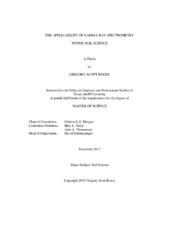| dc.description.abstract | Detailed spatial soil information is needed to better address environmental challenges across regional, national, and global scales. In the U.S., point-scale soil data are available to provide information on chemical and physical properties of soil as well as polygons where soils occur on the landscape. However, the soil data suffer from several shortcomings in terms of internal consistency as well as an inaccurate portrayal of soil variability. Passive aerial gamma-ray radiometrics is a tool that has been successfully used to represent soil variation because it may represent changes in parent materials. Legacy aerial gamma radiometric data is currently available across the United States but as such, has not been compared with soil properties. Therefore, the overall objective of this study was to assess the applicability of aerial gamma-ray spectrometry for the application of mapping soil properties associated across the U.S. Gamma radiometrics were compared with legacy soil samples across the United States. The quality of the initial aerial gamma-ray surveys were assessed by first comparing soil properties against with proximal gamma-ray surveys, followed by proximal and aerial radiometric comparisons within different parent materials in the state of Texas.
After determining that aerial gamma radiometric variation is best understood in terms of physiography, results indicated weak to moderately significant relationships between the two datasets for soil properties such as soil texture and cation-exchange capacity. Results support the conclusion that the soil sampling locations as well as the poor spatial resolution of the legacy gridded gamma radiometric data contribute to low correlation coefficients. Proximal survey results indicate that aerial gamma-ray spatial patterns are related with soil properties such as texture and inorganic carbon within different parent materials. Results also indicate that poor geo-spatial positioning of aerial surveys drives the decrease in quality of correlations with soil data on the ground. Aerial gamma-ray spectrometry has utility for mapping soil properties, but consideration must first be given toward parent material and physiography type. Future studies should consider understanding aerial gamma radiometrics in the United States by surveying additional parent materials not present in this study. | en |


